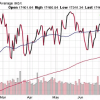Sorry, no content matched your criteria.
Featured Story
This Market Shape Is More Telling Than a "Death Cross"

The major U.S. indices are still right about where they started the month, and the Dow Jones is showing a technical indicator called the "death cross."
A death cross gives an indication of some weakness in the average.
But the S&P 500 shows another indicator that is more telling...
The major U.S. indices are still right about where they started the month, and the Dow Jones is showing a technical indicator called the "death cross."
A death cross gives an indication of some weakness in the average.
But the S&P 500 shows another indicator that is more telling...
